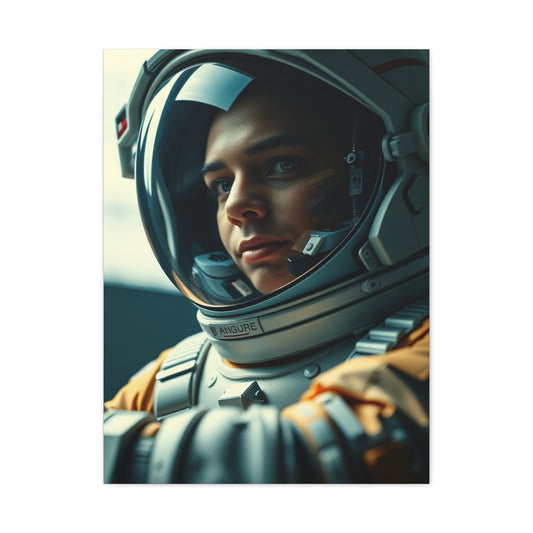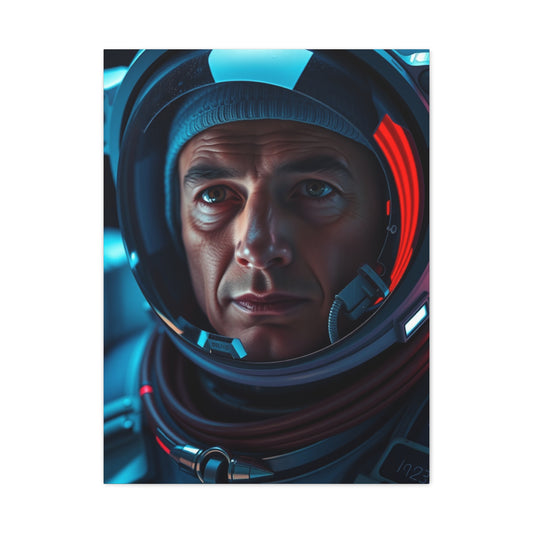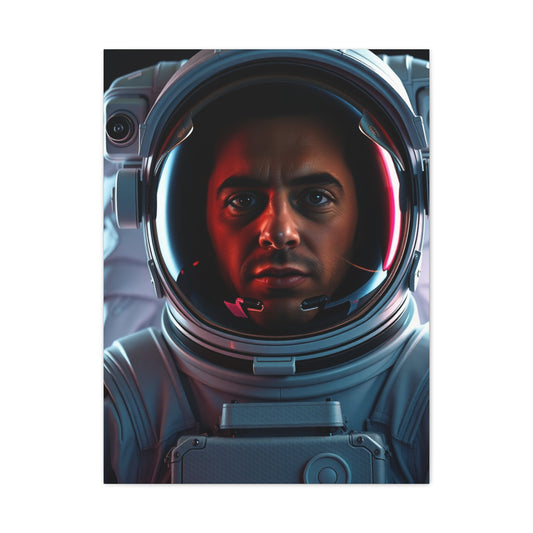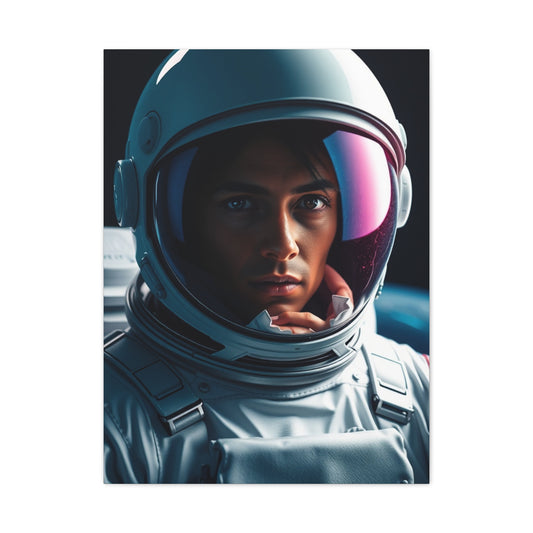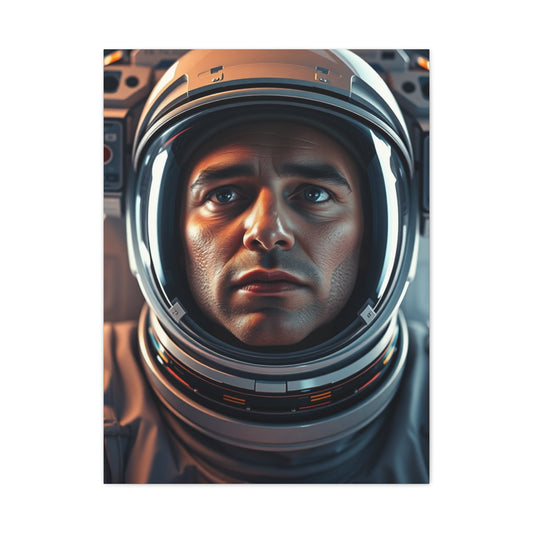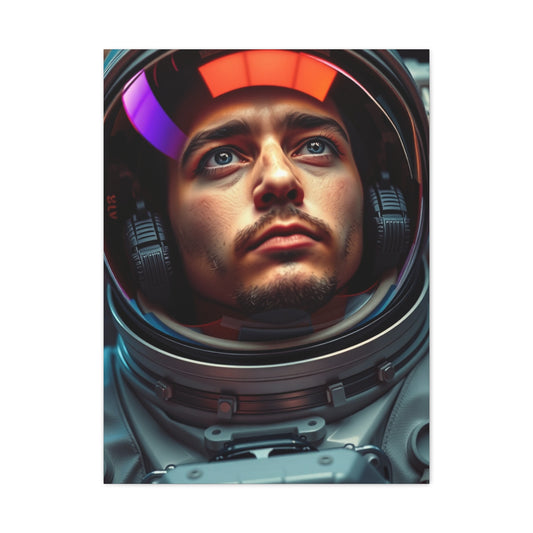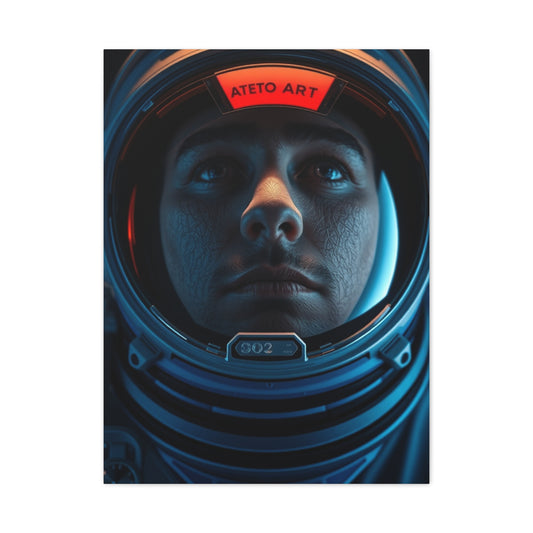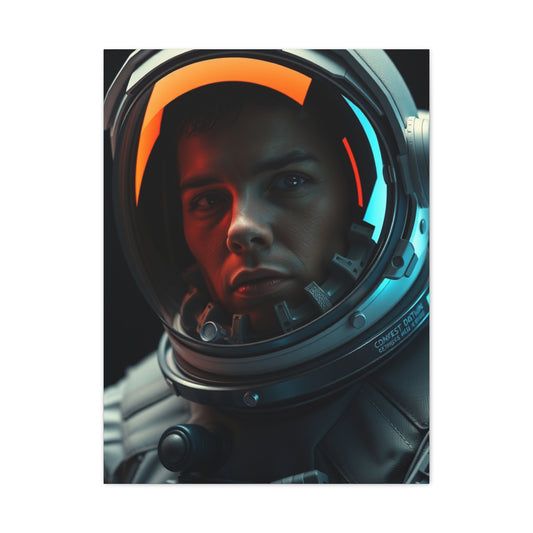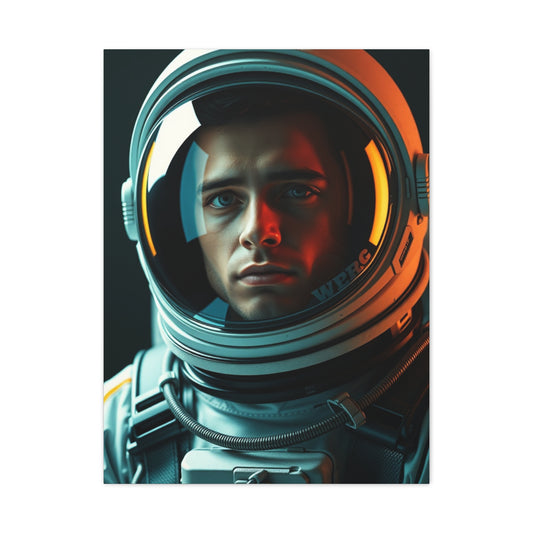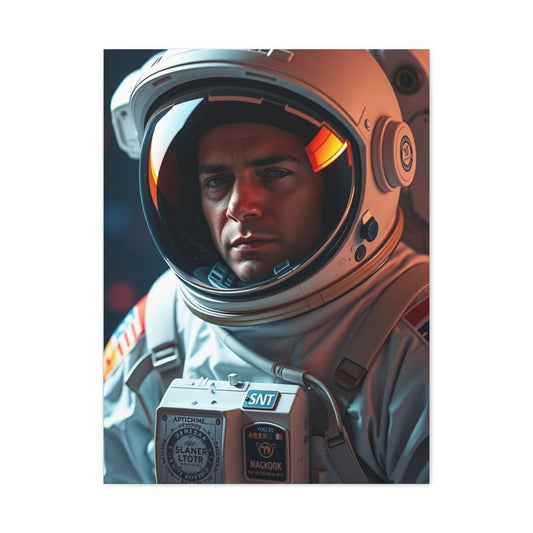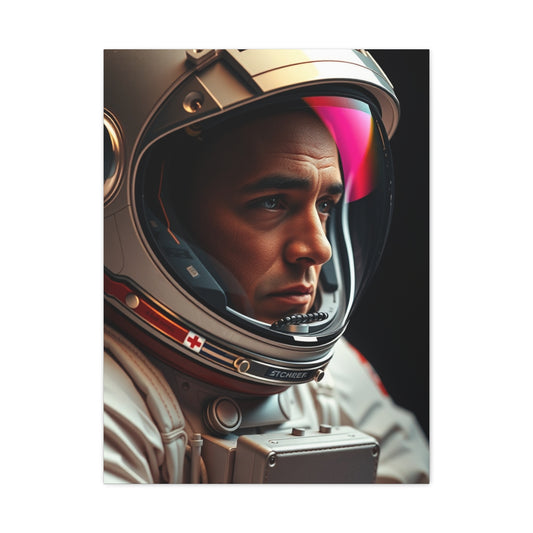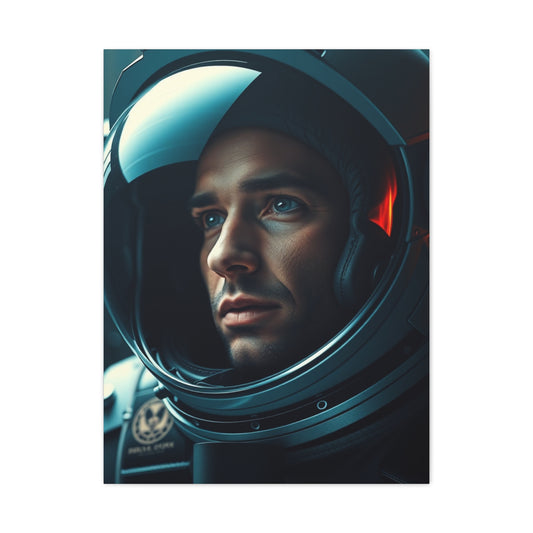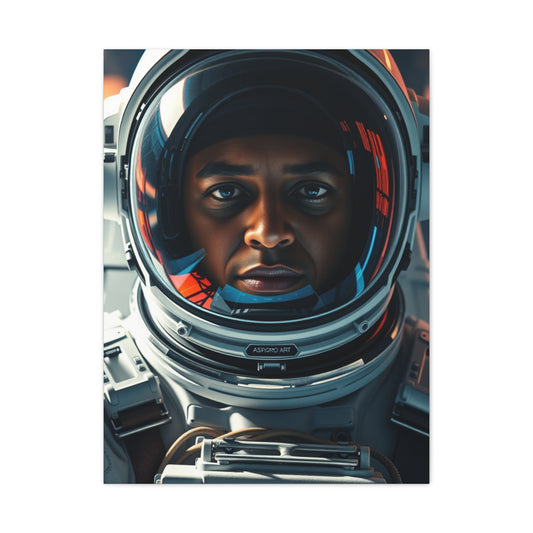Space-Themed Astronaut Wall Art or Nature-Inspired Landscape Wall Décor? A Comprehensive Guide to Transforming Any Room
Creating an aesthetically pleasing and emotionally resonant living environment requires thoughtful consideration of numerous decorative elements, with wall art serving as one of the most impactful components in establishing the overall ambiance and character of any interior space. Unlike furniture or flooring, which primarily serve functional purposes, wall art acts as an expressive layer that reflects individuality and taste while shaping the mood of the environment. It can transform otherwise plain walls into storytelling surfaces that communicate identity, aspiration, and emotion. Whether you find yourself gravitating toward the mesmerizing allure of cosmic exploration imagery or the tranquil serenity of natural landscape compositions, understanding the fundamental principles behind effective wall art selection can dramatically enhance both your home’s visual appeal and your personal satisfaction.
The decision between incorporating space-themed artistic expressions versus nature-inspired visual elements represents more than a simple aesthetic choice; it reflects your personal values, interests, and the psychological atmosphere you wish to cultivate within your living environment. Cosmic and astronomical artwork, for example, often carries with it an element of mystery, wonder, and intellectual curiosity. It speaks to humankind’s eternal quest to explore the unknown and can introduce a futuristic, modern, and contemplative feel to your interiors. Starry galaxies, planets, and nebulae can inspire imagination, providing daily reminders of the infinite possibilities that exist beyond our immediate world. Such art often works exceptionally well in contemporary or minimalist spaces, where clean lines and modern furnishings are complemented by dramatic, expansive visuals that provoke thought and conversation.
In contrast, nature-inspired wall art leans into themes of grounding, balance, and restorative energy. Images of mountains, forests, waterfalls, and sunsets evoke the calming rhythm of the natural world. They offer a sanctuary-like quality, reminding inhabitants of the beauty and tranquility that can be found outside the chaos of modern life. Incorporating natural landscapes into your home décor fosters relaxation, reduces stress, and helps establish a harmonious atmosphere that supports well-being. These types of visuals are particularly suited for bedrooms, reading corners, or living rooms where serenity is prioritized. Furthermore, nature art tends to blend seamlessly with a wide variety of design styles, from rustic and bohemian to Scandinavian minimalism and even luxurious classic interiors.
Contemporary interior design philosophy emphasizes the importance of creating cohesive visual narratives that not only reflect the inhabitant’s personality but also maintain functional harmony throughout the living space. This means that wall art should not be chosen in isolation but instead considered as part of a broader story that connects furniture, textures, colors, and lighting. For instance, a cosmic-themed wall mural paired with sleek metallic accents, glass surfaces, and smart lighting can result in a futuristic yet warm atmosphere. On the other hand, a collection of framed botanical prints against earth-toned walls and natural wood furniture can achieve a cohesive and welcoming environment that celebrates organic simplicity.
Another essential factor is the emotional response art evokes. Astronomical art often inspires awe, sparking curiosity about what lies beyond and motivating viewers to think beyond their immediate circumstances. It can infuse a space with energy and stimulate creativity, making it particularly suitable for workspaces, home offices, or study areas where focus and innovation are encouraged. Nature art, in contrast, primarily soothes and restores, making it perfect for spaces where rest and emotional balance are vital. Understanding this psychological interplay ensures that your wall art contributes not just to aesthetics but also to the overall functionality of the environment.
Beyond style and psychology, practicality also plays a role. Large-scale cosmic canvases can serve as bold focal points, requiring fewer additional decorations, while smaller framed nature prints can be grouped together to create gallery walls that provide visual variety and storytelling through multiple perspectives. Materials also matter: metallic finishes on cosmic prints can highlight the futuristic theme, while textured wood or canvas frames for nature imagery can enhance the organic feel.
Ultimately, the choice between cosmic exploration and natural landscapes is not strictly binary. Many homes benefit from a combination of both, creating layered atmospheres that balance inspiration with grounding. A living room might feature a dramatic galaxy print to spark conversation, while bedrooms and meditation corners highlight tranquil forests or ocean scenes for restoration. The beauty of wall art lies in its versatility—it allows you to curate an environment that evolves with your mood, values, and aspirations.
Understanding the Psychological Impact of Space-Themed Artistic Expressions
Space-themed wall art possesses an inherently inspirational quality that can stimulate intellectual curiosity, foster imaginative thinking, and create an atmosphere conducive to contemplation and wonder. These artistic representations often feature bold color palettes, dramatic contrasts, and compositional elements that draw the viewer's attention toward expansive cosmic vistas, encouraging a sense of adventure and exploration within the domestic environment.
The psychological effects of cosmic imagery extend beyond mere visual stimulation, as these representations can evoke feelings of limitless possibility, scientific curiosity, and philosophical contemplation about humanity's place within the broader universe. Many individuals find that space-themed artwork serves as a daily reminder of the vastness and mystery surrounding our existence, potentially inspiring personal growth, creativity, and ambitious goal-setting behaviors.
Research in environmental psychology suggests that exposure to imagery depicting vast, open spaces can positively influence cognitive function, reduce feelings of claustrophobia, and promote mental flexibility. Astronaut art, planetary landscapes, and galactic scenes can create the illusion of expanded physical boundaries within confined interior spaces, making rooms appear larger and more dynamic than their actual dimensions might suggest.
Furthermore, space-themed artwork often incorporates futuristic design elements, metallic accents, and technological motifs that can complement modern architectural features and contemporary furniture selections. This compatibility makes cosmic art particularly suitable for urban living environments, minimalist design schemes, and spaces that emphasize innovation and forward-thinking aesthetics.
The color psychology associated with space-themed artwork typically involves deep blues, purples, silvers, and blacks, which can create a sophisticated and contemplative atmosphere while providing excellent contrast opportunities for lighter furniture and decorative accessories. These color combinations often promote feelings of tranquility during evening hours while maintaining visual interest and engagement throughout the day.
Exploring the Therapeutic Benefits of Natural Landscape Wall Art
Natural landscape wall art offers an entirely different set of psychological and aesthetic advantages that can transform any living space into a sanctuary of peace, relaxation, and emotional restoration. These artistic representations typically feature organic forms, earth-tone color palettes, and compositional elements that mirror the calming patterns found throughout the natural world.
The biophilic design principle, which emphasizes the human connection to natural environments, suggests that incorporating nature-inspired artwork can significantly reduce stress levels, improve air quality perception, and enhance overall well-being within indoor spaces. Forest scenes, mountain vistas, ocean panoramas, and botanical illustrations can create powerful emotional connections that promote relaxation and mental clarity.
Studies in therapeutic environment design have demonstrated that exposure to nature imagery can lower blood pressure, reduce anxiety levels, and improve recovery rates in various healthcare settings. These same benefits can be realized within residential environments, making natural landscape art particularly valuable for bedrooms, meditation spaces, and areas designated for rest and rejuvenation.
The color psychology associated with nature-themed artwork typically involves greens, browns, earth tones, and soft blues that can create a harmonious and balanced atmosphere while promoting feelings of stability, growth, and connection to the natural world. These color combinations work exceptionally well with wooden furniture, natural fiber textiles, and organic architectural elements.
Natural landscape art also possesses the advantage of timeless appeal, as these representations tend to transcend temporary design trends and maintain their emotional resonance across different life stages and changing personal preferences. The universal human connection to natural environments ensures that nature-themed artwork will continue providing psychological benefits and aesthetic satisfaction for years to come.
Additionally, natural landscape imagery can serve as a substitute for actual outdoor experiences when physical access to natural environments is limited by geographic location, mobility restrictions, or time constraints. This vicarious connection to nature can be particularly valuable for urban dwellers who may have limited opportunities for regular outdoor recreation and natural environment exposure.
Strategic Placement Considerations for Cosmic Exploration Artwork
The strategic placement of space-themed wall art requires careful consideration of room function, lighting conditions, and existing decorative elements to maximize both visual impact and psychological benefits. Different rooms within the home offer unique opportunities for showcasing cosmic imagery while serving specific functional and emotional purposes.
Bedrooms represent ideal locations for astronaut and space exploration artwork, as these intimate spaces benefit from the contemplative and inspirational qualities associated with cosmic imagery. The peaceful nature of space scenes can promote relaxation before sleep while encouraging vivid dreams and creative thinking during rest periods. Consider positioning large-scale cosmic prints opposite the bed to create a focal point that draws attention without overwhelming the space.
Home offices and study areas can be dramatically enhanced through the incorporation of space-themed artwork, as these environments benefit from the intellectual stimulation and forward-thinking mindset that cosmic imagery can inspire. The placement of astronaut portraits or planetary landscapes within the peripheral vision can subconsciously encourage innovative thinking and ambitious project planning during work sessions.
Hallways and corridors provide excellent opportunities for creating dramatic visual impact through the strategic placement of space-themed artwork, as these transitional spaces can accommodate bold compositions that might overwhelm smaller, more intimate rooms. Consider creating gallery walls featuring multiple space exploration images to transform mundane passageways into inspiring journey experiences.
Living rooms and family gathering spaces can successfully incorporate cosmic artwork when balanced with appropriate lighting and complementary decorative elements. The key lies in selecting pieces that enhance rather than dominate the social atmosphere, allowing for comfortable conversation while providing visually engaging focal points that reflect the inhabitants' interests and values.
Entertainment areas, gaming rooms, and technology-focused spaces naturally complement space-themed artwork, as these environments often feature modern equipment and futuristic design elements that harmonize with cosmic imagery. The placement of large-scale astronaut or spacecraft scenes can reinforce the technological sophistication of these spaces while creating immersive environmental experiences.
Optimal Positioning Strategies for Natural Landscape Wall Art
Natural landscape artwork offers exceptional versatility in terms of placement options, as these representations can enhance virtually any room within the home while providing consistent emotional and aesthetic benefits. The key to successful placement lies in understanding how different natural scenes can support specific room functions and desired atmospheric qualities.
Dining areas benefit tremendously from natural landscape artwork, as these social spaces are enhanced by the peaceful and welcoming qualities associated with nature imagery. Forest scenes, pastoral landscapes, or botanical illustrations can create a calm backdrop for meal sharing and conversation, promoting digestion and social bonding. Consider positioning nature artwork at eye level when seated to ensure optimal viewing angles during dining experiences.
Bathroom spaces, often overlooked in decorative planning, can be transformed through the strategic incorporation of nature-themed artwork that emphasizes tranquility and rejuvenation. Water-based landscapes, such as ocean scenes or waterfall imagery, can create thematic continuity with the room's function while promoting relaxation during bathing and personal care routines.
Master bedrooms and guest accommodations are ideal locations for larger natural landscape pieces that can serve as statement walls while promoting restful sleep and peaceful awakening experiences. Mountain vistas, sunrise scenes, or gentle forest imagery can create a sense of escape from daily stresses while maintaining the sophisticated aesthetic appeal that these important spaces require.
Reading nooks, meditation spaces, and quiet contemplation areas can be dramatically enhanced through carefully selected natural landscape artwork that supports introspection and mental clarity. Consider positioning artwork at comfortable viewing angles that allow for extended observation without causing neck strain or visual fatigue during extended use periods.
Children's rooms and nurseries can benefit from gentle natural landscape imagery that introduces young minds to the beauty and diversity of the natural world while avoiding potentially frightening or overly stimulating visual elements. Farm scenes, garden imagery, or peaceful animal habitats can provide educational value while creating nurturing environments for rest and play.
Color Coordination and Harmony Principles
Successful wall art integration requires sophisticated understanding of color theory and its practical application within residential interior design contexts. Both cosmic exploration and natural landscape artwork offer distinct color palettes that can either complement or clash with existing room elements, making careful coordination essential for achieving desired aesthetic outcomes.
Space-themed artwork typically features dramatic color contrasts, metallic accents, and deep saturated hues that can serve as either dominant focal points or sophisticated accent elements depending on the overall room design strategy. The key lies in understanding how these bold cosmic colors interact with existing furniture, textile selections, and architectural features to create either harmonious balance or intentional dramatic tension.
When incorporating space-themed art into neutral color schemes, consider how the artwork's bold blues, purples, and metallic elements can serve as energizing accent colors that prevent the space from appearing bland or uninspiring. These cosmic colors can be echoed through smaller decorative accessories, throw pillows, or lighting fixtures to create visual continuity throughout the room.
Natural landscape artwork offers more subtle color coordination opportunities, as these pieces typically feature earth tones, organic hues, and gentle transitions that can easily integrate with most existing color schemes. The challenge lies in avoiding monotonous color combinations that lack visual interest and fail to create engaging focal points within the space.
The successful integration of nature-themed artwork often involves identifying the dominant and accent colors within the piece and echoing these hues through complementary decorative elements such as plants, natural fiber rugs, wooden furniture pieces, or stone accessories. This approach creates a cohesive design narrative that reinforces the connection between indoor and outdoor environments.
Consider the psychological impact of color combinations when selecting artwork for specific rooms, as different color palettes can significantly influence mood, energy levels, and behavioral patterns. Warm natural tones may be more appropriate for social gathering spaces, while cool cosmic colors might better support focused work environments or peaceful sleep areas.
Lighting Considerations and Enhancement Techniques
Proper lighting design plays a crucial role in maximizing the visual impact and emotional resonance of wall art, regardless of whether you choose cosmic exploration or natural landscape imagery. Understanding how different lighting conditions affect color perception, contrast levels, and overall aesthetic appeal can significantly enhance your artwork investment and daily viewing experience.
Natural lighting conditions throughout the day can dramatically alter the appearance of wall art, making it essential to observe potential artwork under various illumination scenarios before making final placement decisions. Morning light tends to emphasize warm colors and create gentle shadows, while afternoon and evening illumination can intensify contrast levels and reveal subtle details that might be overlooked under different conditions.
Artificial lighting systems offer greater control over artwork presentation, allowing for customized illumination that highlights specific features, creates desired atmospheric effects, and adapts to changing functional requirements throughout the day. Consider installing adjustable track lighting, picture lights, or accent spotlights that can be modified to accommodate seasonal variations or special occasions.
Space-themed artwork often benefits from dramatic lighting techniques that emphasize the cosmic scale and mysterious qualities of the imagery. Backlighting, colored accent lighting, or LED strip installations can create immersive environmental effects that transform static artwork into dynamic visual experiences reminiscent of actual space exploration encounters.
Natural landscape artwork typically responds well to softer, more diffused lighting approaches that mimic the gentle illumination found in outdoor environments. Warm white LED fixtures, soft spotlights, or ambient room lighting can enhance the peaceful and welcoming qualities associated with nature imagery while avoiding harsh shadows or glare that might detract from the viewing experience.
Consider the impact of screen glare and reflective surfaces when positioning artwork in rooms containing televisions, computer monitors, or large windows. Strategic placement and appropriate lighting can minimize unwanted reflections while ensuring optimal viewing conditions throughout various daily activities and seasonal changes.
Scale and Proportion Guidelines for Maximum Impact
Understanding appropriate scale and proportion relationships represents one of the most critical factors in successful wall art integration, as incorrectly sized pieces can overwhelm small spaces or appear insignificant within larger rooms. Both cosmic and natural landscape artwork require careful consideration of viewing distances, room dimensions, and surrounding decorative elements to achieve optimal visual impact.
Large-scale artwork pieces can create dramatic focal points that anchor entire rooms and establish dominant design themes, but they require sufficient wall space and viewing distances to be appreciated properly. Consider the typical viewing positions within each room and ensure that oversized pieces can be observed comfortably without causing visual strain or requiring uncomfortable positioning.
Medium-scale artwork offers greater placement flexibility and can be successfully incorporated into most residential spaces without overwhelming existing decorative elements. These versatile pieces can serve as primary focal points in smaller rooms or function as supporting elements within larger, more complex design schemes.
Small-scale artwork requires strategic grouping and careful placement to achieve significant visual impact, but offers advantages in terms of budget considerations, placement flexibility, and the ability to create varied collections that can be modified over time. Consider creating gallery wall arrangements that combine multiple smaller pieces into cohesive larger compositions.
The golden ratio principle, which suggests optimal proportion relationships of approximately 1.6:1, can provide guidance for selecting artwork dimensions that naturally appeal to human visual perception patterns. This mathematical relationship appears throughout nature and has been utilized in artistic composition for centuries to create inherently pleasing aesthetic arrangements.
Consider the impact of furniture placement and room traffic patterns when determining appropriate artwork scales, as pieces positioned above seating areas or in high-traffic zones may require different sizing considerations than those placed in more private or contemplative locations.
Creating Cohesive Design Narratives Through Mixed Media Approaches
Contemporary interior design increasingly embraces eclectic approaches that combine multiple artistic styles, themes, and media types to create personalized environments that reflect complex individual interests and aesthetic preferences. The integration of both cosmic exploration and natural landscape artwork within the same living space can create sophisticated design narratives that celebrate human curiosity about both earthly and celestial realms.
The key to successful mixed media integration lies in identifying common visual elements, color relationships, or thematic connections that can serve as unifying factors throughout the space. Consider how the scale of cosmic imagery relates to the vastness of natural landscapes, or how the wonder inspired by space exploration parallels the awe evoked by spectacular natural phenomena.
Transitional spaces such as hallways, stairwells, or open floor plan areas provide excellent opportunities for gradually introducing different artistic themes while maintaining visual continuity throughout the home. Consider creating progressive arrangements that begin with earthbound natural imagery and gradually transition toward cosmic exploration themes as viewers move through the space.
Seasonal rotation strategies can allow for regular refresh of wall art displays while accommodating both cosmic and natural landscape preferences throughout different times of the year. Summer months might emphasize outdoor natural scenes, while winter periods could feature more contemplative cosmic imagery that encourages indoor reflection and imagination.
The use of consistent framing materials, matting techniques, or mounting systems can provide visual continuity even when combining dramatically different artistic themes. Consider developing a signature presentation style that can accommodate various artwork types while maintaining recognizable aesthetic consistency throughout the home.
Digital artwork and customizable printing technologies offer unprecedented opportunities for creating personalized combinations that merge cosmic and natural elements into unique hybrid compositions. These innovative approaches can produce truly one-of-a-kind pieces that perfectly reflect individual aesthetic preferences while incorporating multiple thematic elements.
Budget-Conscious Strategies for Art Acquisition and Display
Developing an impressive wall art collection requires strategic planning and budget management, particularly when considering larger pieces or multiple artwork acquisitions over time. Understanding various acquisition methods, display alternatives, and long-term collection strategies can help maximize aesthetic impact while maintaining financial responsibility.
Print reproduction technologies have revolutionized artwork accessibility, allowing high-quality reproductions of famous cosmic photography, space exploration imagery, and natural landscape photography at fraction of original artwork costs. These reproductions can provide excellent visual impact while preserving budget resources for other decorative elements or future artwork additions.
Local artist communities, art schools, and emerging talent networks offer opportunities to acquire original artwork at reasonable prices while supporting regional creative economies. Many emerging artists specialize in cosmic or natural themes and may be willing to create custom pieces that perfectly match specific space requirements and personal preferences.
Rotation and storage strategies can extend the effective value of artwork investments by allowing periodic display changes that maintain visual freshness without requiring constant new acquisitions. Consider developing organized storage systems that protect artwork while making periodic exchanges convenient and enjoyable.
DIY framing and mounting projects can significantly reduce overall artwork costs while providing opportunities for customization that perfectly matches existing room décor. Learning basic framing techniques and investing in quality materials can produce professional-looking results while building valuable skills for future projects.
Online marketplaces, estate sales, and consignment shops often provide access to quality artwork at reduced prices, particularly for pieces that may have fallen out of current style trends but possess enduring aesthetic appeal. Patient searching and regular monitoring can yield exceptional finds that might otherwise remain inaccessible due to budget constraints.
Technology Integration and Modern Display Solutions
Contemporary wall art display increasingly incorporates technological innovations that enhance viewing experiences, provide interactive features, and adapt to changing personal preferences or environmental conditions. These modern approaches can significantly amplify the impact of both cosmic and natural landscape artwork while adding functional benefits that traditional static displays cannot provide.
Digital picture frames and rotating display systems allow for extensive artwork collections to be enjoyed within limited wall space, providing opportunities to regularly refresh room atmospheres while accommodating diverse artistic preferences. High-resolution displays can showcase detailed cosmic photography or intricate natural landscape imagery with clarity that rivals traditional print media.
Smart lighting systems can be programmed to automatically adjust illumination throughout daily cycles, ensuring optimal viewing conditions while reducing energy consumption and extending artwork longevity. These systems can create dramatic effects for space-themed artwork during evening hours or gentle enhancement for natural landscape pieces during morning periods.
Augmented reality applications enable virtual artwork trials before making purchase decisions, allowing homeowners to visualize how different pieces will appear within specific spaces and lighting conditions. These tools can eliminate costly placement mistakes while building confidence in artwork selection decisions.
Interactive projection systems can transform blank walls into dynamic display surfaces capable of showcasing rotating collections of cosmic imagery or natural landscape scenes. These installations can respond to occupancy, time of day, or seasonal changes to create continuously evolving environmental experiences.
Voice-activated control systems can integrate artwork lighting, rotation schedules, and environmental settings into broader home automation networks, providing convenient management capabilities while ensuring optimal presentation conditions at all times.
Maintenance and Preservation Best Practices
Protecting artwork investments requires understanding proper care techniques, environmental considerations, and preventive maintenance practices that extend longevity while preserving visual quality over time. Both cosmic and natural landscape artwork face similar preservation challenges that can be addressed through proactive planning and regular maintenance routines.
Environmental factors such as humidity levels, temperature fluctuations, and air quality can significantly impact artwork condition, particularly for pieces utilizing certain printing materials or mounting techniques. Understanding these vulnerabilities enables proactive protection measures that prevent damage before it occurs.
Dust accumulation represents one of the most common threats to artwork appearance and longevity, as particles can embed in surface textures and create permanent discoloration over time. Developing regular cleaning schedules using appropriate materials and techniques can maintain visual clarity while preventing cumulative damage.
Direct sunlight exposure can cause fading, color shifts, and material degradation in both photographic prints and painted artwork. Strategic placement away from intense solar radiation, combined with UV-filtering window treatments or protective glazing, can significantly extend artwork lifespan while maintaining color accuracy.
Proper mounting and support systems prevent physical stress that can cause warping, tearing, or separation over time. Understanding weight distribution, wall attachment methods, and environmental movement can ensure secure installation that protects both artwork and wall surfaces.
Professional cleaning and restoration services may be necessary for valuable pieces or those showing signs of deterioration. Establishing relationships with qualified conservators before problems develop can facilitate prompt treatment when needed while maintaining artwork value and appearance.
Future Trends and Emerging Possibilities
The world of wall art is undergoing a fascinating transformation, shaped by technological innovations, evolving lifestyle choices, and new artistic directions that continue to blur the lines between cosmic exploration themes and natural landscape imagery. These shifts highlight not only aesthetic trends but also broader cultural changes that influence how people relate to their living environments. By examining these future possibilities, homeowners, collectors, and interior designers can make more informed decisions that enhance current spaces while remaining adaptable to the creative opportunities of tomorrow.
One of the most prominent trends reshaping the art industry is the growing emphasis on sustainability and eco-conscious practices. Consumers are increasingly aware of the environmental impact of their purchases, and wall art is no exception. Many manufacturers are responding with greener solutions, such as using recycled canvases, eco-friendly inks, sustainably sourced wood for framing, and carbon-neutral shipping methods. These initiatives align closely with nature-inspired themes, as customers drawn to images of forests, oceans, and landscapes often seek harmony with the environment in their décor. Interestingly, this eco-conscious movement is also extending to cosmic artwork production, where sustainability efforts underscore the idea of protecting not just our planet but the greater universe we are part of. This holistic mindset ensures that wall art doesn’t just decorate a home but also reflects a lifestyle of responsibility and care.
Another important development lies in the growing popularity of personalization and customization. Today’s consumers value individuality and uniqueness in their home décor, and advanced printing technologies are making it easier than ever to achieve this. Online platforms and design tools now allow customers to upload personal photographs, adjust colors, select specific sizes, or even merge different themes into one composition. Imagine a piece of wall art that blends the majesty of the Milky Way with the serenity of a mountain range—such customizations give homeowners the chance to create highly personal works that speak directly to their values and preferences. As these technologies continue to evolve, personalization will become more accessible and affordable, empowering more people to curate spaces that are authentic reflections of themselves.
Community-driven and collaborative artwork projects are also emerging as a powerful trend. These initiatives invite multiple artists, designers, or even everyday individuals to contribute to a shared piece of art. The outcome often represents a collective vision, merging diverse styles and ideas into a singular narrative. For example, a collaborative mural might feature cosmic motifs seamlessly woven into natural landscapes, symbolizing unity between the earth and the universe. Beyond aesthetics, such projects foster community engagement and social connection, making art not just a decorative object but a shared cultural experience.
The integration of virtual reality (VR) and augmented reality (AR) represents another groundbreaking direction for wall art. These technologies enable immersive experiences that go far beyond static visuals. Through AR applications, homeowners could preview how a cosmic or nature-themed artwork would look on their wall before purchasing. VR experiences could transport viewers directly into breathtaking galaxies or tranquil forest paths, offering a new dimension of interactivity. As these tools become more mainstream, they may revolutionize how art is experienced in the home, allowing it to shift from passive decoration to dynamic engagement.
Artificial intelligence (AI) and machine learning are set to play an equally transformative role in the future of wall art. Algorithms can now analyze a person’s décor preferences, lifestyle patterns, and even room characteristics—such as lighting, color palette, or spatial layout—to recommend suitable artworks. These systems not only simplify the decision-making process but also introduce consumers to artists, genres, or themes they might not have discovered otherwise. For instance, an AI system might suggest a cosmic-themed artwork that pairs perfectly with a futuristic interior, or a nature-inspired piece that balances the energy of a modern, industrial-style room. Over time, these AI-driven platforms may evolve into highly intuitive art advisors, bridging the gap between consumers and creators in meaningful ways.
In conclusion, the future of wall art promises a dynamic blend of creativity, technology, and sustainability. With eco-conscious practices shaping production, personalization allowing for greater individuality, collaborative projects fostering community, and VR/AR expanding interactivity, the possibilities for artistic expression are more exciting than ever. Artificial intelligence further ensures that consumers can navigate this evolving landscape with guidance tailored to their unique tastes and lifestyles. Whether one’s preference leans toward the infinite wonder of the cosmos or the grounding serenity of nature, future innovations in wall art will provide unprecedented opportunities to experience, curate, and live with art in transformative ways.
Conclusion
The choice between cosmic exploration art and natural landscape wall décor ultimately reflects deeply personal preferences, lifestyle considerations, and aesthetic goals that extend far beyond simple visual appeal. Throughout this comprehensive exploration, we have examined the multifaceted aspects of both artistic categories, revealing that each offers unique psychological benefits, aesthetic possibilities, and practical advantages that can significantly enhance residential living environments.
Cosmic exploration artwork provides inspirational qualities that stimulate intellectual curiosity, encourage ambitious thinking, and create atmospheric conditions conducive to innovation and forward-looking perspectives. The bold color palettes, dramatic compositions, and futuristic themes associated with space-themed art can transform ordinary living spaces into environments that celebrate human achievement, scientific discovery, and the limitless possibilities that await exploration. These pieces work particularly well in modern, technology-focused homes where residents value progress, adventure, and connection to broader universal themes.
Natural landscape wall art offers therapeutic benefits that promote relaxation, stress reduction, and emotional restoration through connection to organic environments and earth-based color palettes. The timeless appeal, universal human connection to nature, and calming psychological effects make natural landscape artwork suitable for virtually any living situation, from urban apartments seeking escape from city pressures to suburban homes looking to strengthen their connection to outdoor environments. These pieces provide enduring satisfaction that transcends temporary design trends while supporting overall well-being and mental health.
Perhaps most importantly, contemporary interior design philosophy increasingly embraces personalized approaches that reflect individual complexity and diverse interests rather than adherence to rigid stylistic categories. The integration of both cosmic and natural themes within carefully planned design schemes can create sophisticated environments that celebrate the full spectrum of human curiosity and aesthetic appreciation. This approach acknowledges that most individuals possess multifaceted personalities that cannot be adequately expressed through single artistic themes or restrictive design philosophies.
The practical considerations explored throughout this discussion, including strategic placement, lighting enhancement, scale relationships, and budget management, provide essential guidance for making informed decisions that maximize both immediate visual impact and long-term satisfaction. Understanding these factors enables confident artwork selection and installation that will continue providing enjoyment and aesthetic enhancement for years to come.
The technological innovations and emerging trends shaping the wall art landscape promise exciting possibilities for future artistic experiences, from interactive digital displays to personalized creation tools that democratize artistic expression. These developments will likely expand the boundaries between cosmic and natural themes while providing new opportunities for creative exploration and environmental enhancement.
Ultimately, the most successful wall art choices are those that genuinely resonate with the inhabitants' personalities, support their lifestyle needs, and contribute positively to their daily experiences within the home environment. Whether that involves the inspiring vastness of cosmic exploration, the peaceful sanctuary of natural landscapes, or innovative combinations that celebrate both realms, the key lies in thoughtful selection that honors personal preferences while creating spaces that truly feel like home.
The investment in quality wall art represents more than decorative enhancement; it constitutes a commitment to creating living environments that support psychological well-being, inspire daily motivation, and reflect the unique character of those who inhabit the space. By carefully considering the extensive range of factors and possibilities explored in this comprehensive guide, homeowners can make informed decisions that will provide lasting satisfaction and continuous enjoyment of their carefully curated living environments.

